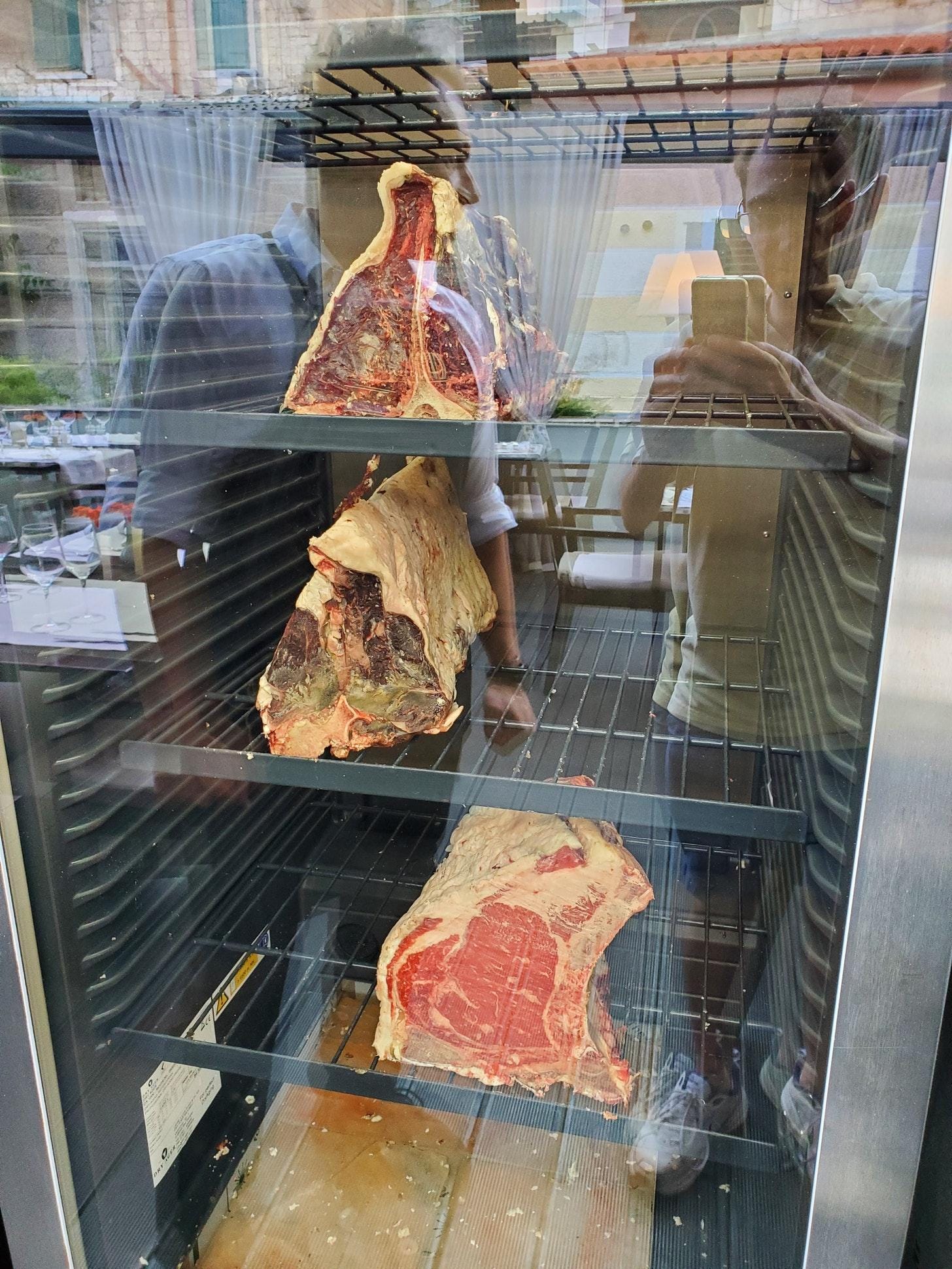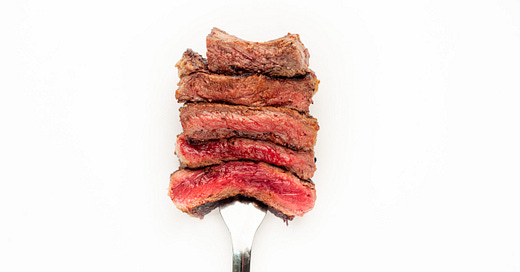
One night in Croatia, during our stay in the venerable port city of Split, my wife and I were feeling something different from the ubiquitous seafood-heavy Mediterranean fare. We both enjoy steak a lot, and so when we found a steakhouse that offered Croatian dry-aged ribeye, we decided to give it a try.
Usually, I don’t do steakhouses; back home, I can buy a very nice red wine and a very nice steak, and for a pretty minimal amount of work make the same dinner for half the price. Sometimes I like ordering familiar food I can cook myself, but a steak is so easy to cook up, and the supermarket offerings have gotten so good, that I can’t justify the price tag.
Here in Croatia, I could. And I’m glad I did. Here the restaurant’s dry-aging cabinet:

(Photo by Addison del Mastro)
And here’s what came to the table:

(Photo by Addison del Mastro)
This was Simmental beef, a breed relatively common in Europe but not so much in the United States. It was very, very good. We ordered it rare, but if anything it was a bit too rare (better than overcooked). We actually asked our waiter if they could toss it back on the grill for just another minute, which they obligingly did. They even re-plated it the same as it looks in the picture.
I noticed something interesting: this steak was very lean, as in little marbling. In America, any expensive steak that a steakhouse bothers to dry age is going to be USDA Prime or something even “better”—better meaning more marbling. The kind of steak you might call “buttery.”
In fact, the whole USDA grading system for beef is not really about quality per se, but marbling. Or rather, marbling is considered the major component of quality. Beef is graded based mostly on the amount of marbling present in the ribeye. You’ll read how “fat is flavor,” how a less marbled steak won’t be as tender and juicy. Yes, this lean ribeye had some chew to it, but it was still tender. It had none of the tough dryness that a cheap American steak will often have. (The other thing this means is that a Prime-graded steer is special mostly for its premium steak cuts, the muscles that don’t do a lot of work. The tougher and more worked top round or eye round, for example, are still Prime, but those cuts aren’t really much different from any other grade.)
Now I said beef is graded “mostly” with the amount of marbling in the ribeye. The other factor is the age of the steer at the time of slaughter. In fact, the four USDA grades of beef you’re likely to see in stores—Prime, Choice, Select, and Standard—all require that the animal be less than 42 months old. That’s three and a half years old. Another source claims it’s impossible to qualify for any of the four top grades under 30 months.
Most commercial beef anywhere is slaughtered at a young age, relatively speaking. But increasingly there’s culinary interest in “old” beef, beyond the age of commercial beef, and beyond the age at which USDA grading is possible. It might not be to everyone’s liking, but it’s not at all inferior. Here’s an interesting article in the Los Angeles Times:
[Chef Teresa Montaño] had just experienced vaca vieja, literally “old cow,” a steak sourced from older steers at the end of their working life. Beef from mature animals—particularly animals raised on pasture by responsible farmers—offers an entirely different eating experience than the melt-in-your-mouth steaks many Americans are accustomed to.
Montaño’s “old” steak was served to her in Spain, and earlier in the article she called it one of the best meals of her life. (Quite the compliment, coming from a chef.) But the article actually profiles a company in the United States trying to source and sell high quality “old beef.”
Another interesting trend is appreciation for beef from older dairy cows, which also cannot be graded. Generally, dairy cows are served in cheaper steakhouses or restaurants, turned into ground beef, or even used for pet food. Until recently, they were at best a cheaper alternative to beef cattle, and a way for dairy farmers to recoup some money.
But starting in the mid-2010s, articles extolling the deep, rich taste of dairy cow steaks began to appear. Many referenced the same American company, Mindful Meats, that markets “old” beef. (Retired dairy cows tend to be “old,” which in this context means typically five or six years, sometimes much more. The company markets both steers and cows.) A few years ago, one expensive restaurant in Washington, D.C. even served a dairy cow tomahawk ribeye. The catch? The meat can be tough, especially if it’s not prepared carefully. That’s the tradeoff for the purported far richer flavor.
My steak in Croatia wasn’t old, nor was it from a dairy cow, but it was, as noted, lean compared to a high-quality American steak. The common idea that “good” beef is young, heavily marbled beef is simply not true. The USDA grading system, and the set of preferences and expectations around beef and in particular steak, artificially take off the table a whole category of potentially very good meat.
Back in April 2021, Epicurious announced that for environmental reasons, it would no longer produce new content about beef. “We know that some people might assume that this decision signals some sort of vendetta against cows—or the people who eat them,” they wrote. “But this decision was not made because we hate hamburgers (we don’t!). Instead, our shift is solely about sustainability, about not giving airtime to one of the world’s worst climate offenders.” That last sentence, taking the same form as a sentence about, say, deplatforming fascists, is curious.
Just this last March, the New York Times published a long essay titled “What Does the End of Beef Mean for Our Sense of Self?” I suppose I missed the memo that the end of beef was nigh. I was also unaware of whatever it is this introductory sentence is referring to: “When it comes to America’s legacy of Manifest Destiny, there’s perhaps no meal more symbolic than a bleeding steak.” Or this one: “For some, that whiff of conquest is a maddening perfume and, arguably, what makes beef so difficult to give up.”
Of course, there is no “end of beef,” unless “end of beef” means something like “defund the police”—a set of fairly bland and ordinary suggestions sloganized and gussied up to look radical.
Maybe the real end of beef is the beginning of a more conscious approach to eating, of making use of resources more carefully instead of using brute force to make things add up. You can see this in architecture—the ubiquity of air conditioning, for example, leading to buildings poorly adapted to their climates in its absence. And perhaps you can see it in the ruthlessly efficient and heavily siloed supply chains that turn old steers and cows into dog food.
“There’s a more environmentally friendly and tastier steak out there (yes, that might cost a little more)” is a very different message from “beef is over.” Learning to make do with less is conservative, not radical. And it can be done without insinuating that inside every beef-loving American there’s a settler-colonialist waiting to pound his fork and knife on the table.
You could also talk to the restaurant owners, or the farmers, who know more about both the economics and the meat than almost anyone. And, just to be sure, you could try one of those steaks yourself.











